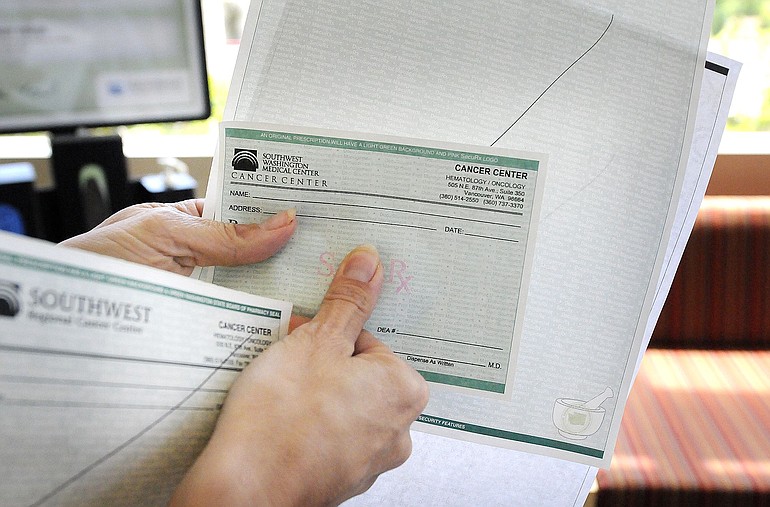About 53,000 health professionals in 13 professions are licensed to write prescriptions in Washington: advanced registered nurse practitioners; certified registered nurse anesthetists; physicians; physician assistants; certified physician assistants; osteopathic physicians and assistants; dentists; veterinarians; naturopathic physicians; optometrists; podiatric physicians; and pharmacists.
SOURCE: State Department of Health
The state has added another element to picking up a prescription, with a new version of tamper-resistant prescription paper going into effect today.
The new pads are designed to cut down on fraud by making the prescription paper harder to alter or copy.
This is the most recent in a series of prescription changes, said Becky Caswell, a pharmacy official at Southwest Washington Medical Center.
The Medicaid program has required tamper-resistant prescription forms for more than a year. Caswell is hoping local prescribers — including dentists and physicians — are keeping up with all the changes.
“A lot of health providers were in compliance with Medicaid,” but might not realize another update took effect today, said Caswell, assistant director of outpatient pharmacy services at the hospital.
“If we receive a prescription written after July 1 on an old form, even if it is tamper-resistant, we will have to call the physician to verify,” she said. “That will really slow us down.”
Although the state can’t quantify the number of forged or altered prescriptions handed to Washington pharmacists, “We’ve seen altered prescriptions where a prescriber’s name is signed fraudulently,” said Susan Boyer, executive director of the Washington State Board of Pharmacy.
“We have to guard against erasures,” Caswell said. “People change the quantity. The doctor writes ‘10’ and they change it to ‘100.’ They give themselves refills. They add a drug, and write ‘Vicodin’ off to the side.”
In the most visible change, a prescription form must have the state Board of Pharmacy seal of approval. It includes the outline of the state, centered within a mortar and pestle.
According to the state Department of Health website, the seal of approval must be printed in an ink that changes colors when exposed to heat or friction — like being rubbed by a pharmacist’s thumb. The seal must return to the original color when it cools.
“With this paper, the pharmacist will know the prescription paper is legitimate when the color changes on the seal,” Boyer said.
There are other fraud-prevention measures.
“In our high-tech age, people can make darned good copies,” Caswell said. “If I try to photocopy this, it says ‘VOID.’”
Other security features are designed to prevent erasures.
The state Department of Health has been telling health-care professionals about the new prescription format since last summer, Boyer said. Still, pharmacy officials are concerned that some practitioners didn’t get the word.
There are some ways to work around that problem. Any prescriber who doesn’t have approved paper on hand can send prescriptions electronically or by fax to a pharmacy, Boyer said.
“This covers the new handwritten ones, so refills are not an issue,” Boyer added.
The legislation calling for the new prescription paper does allow pharmacists to provide medications on an emergency basis. That typically is a three-day supply at Southwest Washington Medical Center, Caswell said, so a paperwork problem should not jeopardize a patient’s life.
Even with a head start on the new prescription forms, Southwest Washington Medical Center still is waiting for all the new versions that will accommodate all its departments and practices.
“We had over 50 different forms,” she said. “We don’t have them all in yet, so we’re using some generic forms.”




